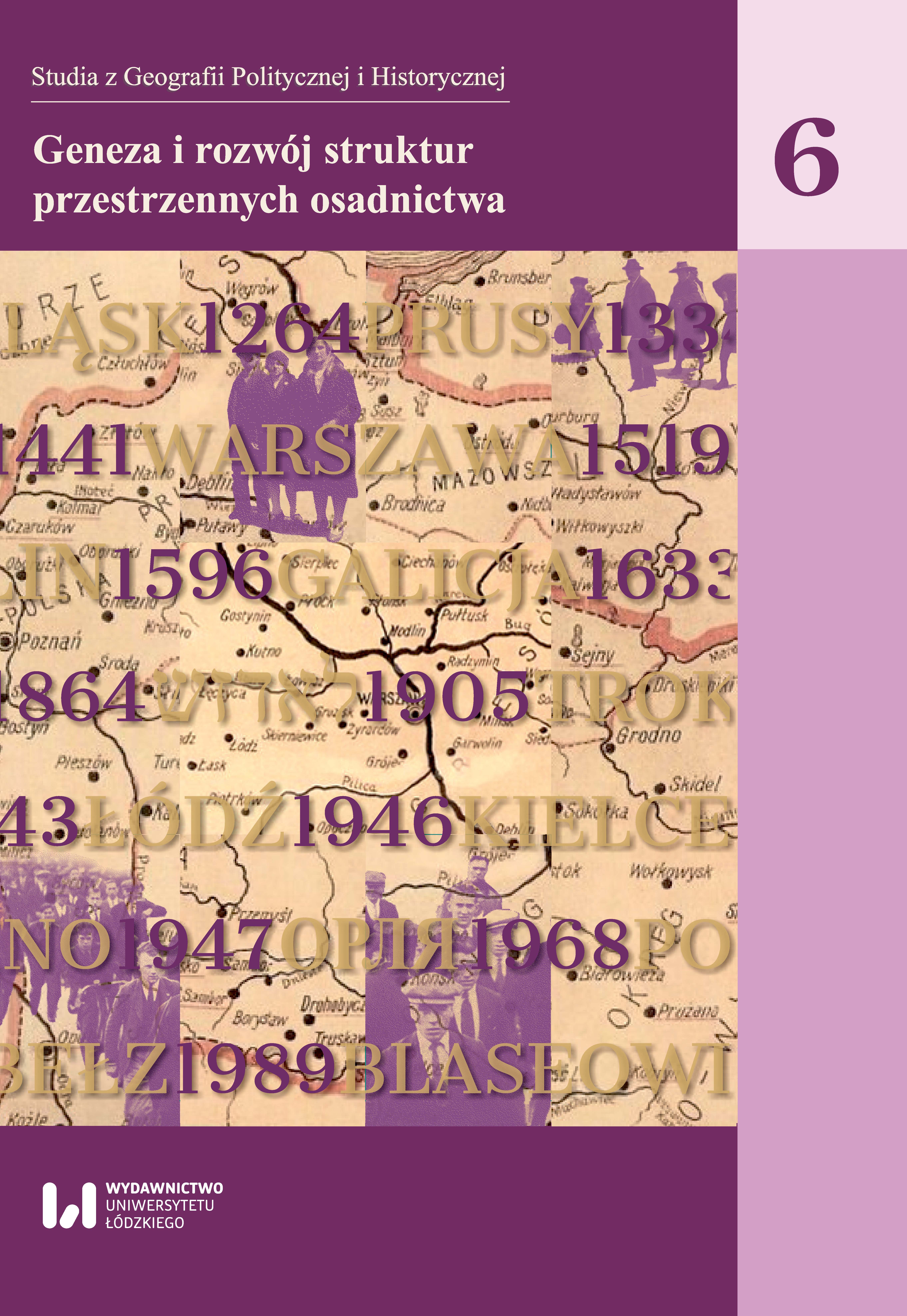Osadnictwo braci czeskich i morawskich w regionie łódzkim
DOI:
https://doi.org/10.18778/2300-0562.06.07Słowa kluczowe:
osadnictwo, kolonizacje, bracia czescy, bracia morawscy, ZelówAbstrakt
Tematem artykułu są migracje i osadnictwo braci czeskich i morawskich na ziemi łódzkiej od XVI do XIX w. oraz pozostałości ich dziedzictwa kulturowego. Pierwszy etap tego osadnictwa to migracje z Czech do Polski na przełomie XVI i XVII w. Drugi etap rozpoczął się na początku XIX w. równocześnie z kolonizacją niemiecką. Większość Czechów osiedlonych na ziemi łódzkiej stanowili bracia czescy, którzy zgłosili akces do Kościoła Ewangelicko-Reformowanego, ale zachowali odrębność języka i nabożeństw. Po drugiej wojnie światowej znaczna część zamieszkałych w regionie Czechów wróciła do ojczyzny. W Zelowie jednak nadal mieszka kilkaset osób deklarujących narodowość czeską i kultywujących swoją kulturę. Bracia morawscy to denominacja religijna, założona w pierwszej połowie XVIII w. na Górnych Łużycach przez protestanckich uchodźców religijnych z Moraw. Zakładali oni swoje osady na całym świecie, w tym także w Imperium Rosyjskim. Największymi placówkami braci morawskich na ziemi łódzkiej były Nowosolna koło Łodzi i Lwówek koło Gąbina. Na przełomie XIX i XX w. zintegrowali się oni z wyznawcami innych kościołów protestanckich w regionie. Pozostały jednak po nich charakterystyczne elementy kultury materialnej: układy urbanistyczne, cmentarze i domy modlitwy.
Bibliografia
Badziak K., Chylak K., Łapa M., 2014, Łódź wielowyznaniowa. Dzieje wspólnot religijnych do 1914 roku. Łódź.
Google Scholar
DOI: https://doi.org/10.18778/7969-512-6
Bem K., 2000, Obecni – 450 lat protestantyzmu na ziemi łódzkiej, „Kalendarz Ewangelicki”, s. 139–146.
Google Scholar
Białecki K., 2009, Walcząc o przetrwanie. Ewangelicy reformowani w Polsce w pierwszych latach po II wojnie światowej, [w:] Kłaczków J. (red.), Polski protestantyzm w czasach nazizmu i komunizmu, Toruń, s. 446–462.
Google Scholar
Dworzaczkowa J., 1997, Bracia Czescy w Wielkopolsce w XVI i XVII wieku, Warszawa.
Google Scholar
Fijałkowski P., 1992, Bracia morawscy w Lwówku, „Notatki Płockie”, 37, s. 9–2.
Google Scholar
Góral K., 2015, Parafia ewangelicko-reformowana w Kleszczowie: www.kleszczow.reformowani.pl (15.08.2015).
Google Scholar
Heroldova I., 1971, Život a kultura ceskych exulantu z 18. stoletni. Praha.
Google Scholar
Karczyńska H., 2012, Odnowiona Jednota Braterska w XVIII–XX wieku. Z dziejów ruchu religijnego herrnhutów w krajach Europy środkowo-wschodniej i na świecie, Warszawa.
Google Scholar
Kulesza M., 2013, Wielokulturowe dziedzictwo Łodzi a współczesny krajobraz miasta, „Studia z Geografii Politycznej i Historycznej”, 2, s. 11–46.
Google Scholar
Małachowska N., 2017, Przyczynek do historii Zboru Ewangelicko-Reformowanego w Łodzi: www.lodz.reformowani.net.pl (02.08.2017).
Google Scholar
Michalak R., 2002, Kościoły protestanckie i władze partyjno-państwowe w Polsce (1945–1956), Warszawa.
Google Scholar
Papuga S., Gramsz A., 2003, Zelów. Wspólnota nacji, wyznań, kultur, Łódź.
Google Scholar
Semotanová E., 1998, Historická geografie českých zemí, Praha.
Google Scholar
Stejskał J., 2015, Bracia czescy w Zelowie, Łodzi i Żyrardowie, „Jednota”, 2, s. 12–16.
Google Scholar
Štéřikova E., 2001, Pozváni do Slezska. Vznik prvních českých emigrantských kolonii v 18. století v pruském Slezsku, Praha.
Google Scholar
Štéřikova E., 2003, 200 lat zelowskiej historii, „Jednota”, 8–9, s. 20–23.
Google Scholar
Štéřikova E., 2005, Země otců: z historie a ze vzpomínek k 50. výročí reemigrace potomků českých exulantů, Praha.
Google Scholar
Štéřikova E., 2010, Zelów. Česká exulantská obec v Polsku, Praha.
Google Scholar
Szczepankiewicz-Battek J., 2001, Kościoły protestanckie pogranicza śląsko-wielkopolskiego, „Myśl Protestancka”, 3 (19), s. 59–66.
Google Scholar
Szczepankiewicz-Battek J., 2005, Łużyce – przestrzeń dysocjacji kultur narodowych i religijnych, Słupsk.
Google Scholar
Szczepankiewicz-Battek J., 2010, Osadnictwo ewangelików reformowanych na Śląsku w ramach kolonizacji fryderycjańskiej, [w:] Obszary metropolitalne we współczesnym środowisku geograficznym, t. 2, Łódź, s. 181–191.
Google Scholar
Szczepankiewicz-Battek J., 2013, Bracia czescy w Kościele Ewangelicko-Reformowanym w Polsce – przeszłość i teraźniejszość, „Studia z Geografii Politycznej i Historycznej”,2, s. 239–262.
Google Scholar
Szczepankiewicz-Battek J., 2015, Śladami braci czeskich i morawskich po Polsce, Warszawa.
Google Scholar
Tobjański Z., 1994, Czesi w Polsce, Kraków.
Google Scholar
Tranda Z., 2012, Za i przeciw w PRL-u. Z perspektywy Kościoła Ewangelicko-Reformowanego, [w:] Kłaczków J., Rodzynkowski W. (red.), Kościoły chrześcijańskiew systemach totalitarnych, Toruń, s. 470–501.
Google Scholar
Wróblewski P., 1996, Społeczność czeska w Zelowie. Problemowa monografia socjologiczna, Warszawa.
Google Scholar
Wróblewski P., 1997, Mniejszość czeska w Zelowie. Tożsamość etniczna i postawy patriotyczne, [w:] Kurcz Z. (red.), Mniejszości narodowe w Polsce, Wrocław, s. 141–147.
Google Scholar
Pobrania
Opublikowane
Jak cytować
Numer
Dział
Licencja

Utwór dostępny jest na licencji Creative Commons Uznanie autorstwa – Użycie niekomercyjne – Bez utworów zależnych 4.0 Międzynarodowe.








